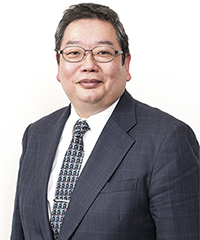Overview
Director's Message

Tetsuo Endoh
Director of CIES
March, 2016
With variety of research seeds at Tohoku university as well as abundant records of university-industry research collaboration, the center for Innovative Integrated Electronic Systems (CIES) was established to construct a stronghold of the international university-industry research collaboration. Three years have passed and entered the second phase since the CIES has started its activity in October 2012. From October 2015, I was continuously appointed to serve as the Director of CIES. I appreciate your continued support and encouragement.
In the primary phase, world top-level talented persons gathered together and we brought together the competitive core technologies and intellectual properties of our university to construct a flexible, robust and diverse organization. In addition, for the field of spintronic integrated circuits, we began working on developing innovative technologies by setting up the common facilities compatible with those at global companies. The center administers the CIES consortium consisting of an international industry-academia consortium with seven industry-academia joint research projects and three large national projects of the Japanese government (JST-ACCEL, CSTI-ImPACT, and NEDO Project). Currently we are involved in work with dozens of companies from Japan and abroad, earning the global recognition as a hub of joint research between industry and academia by accelerating system reforms including intellectual property management, common facility uses and so on to promote industry-academic collaborations. In addition, the companies utilized “a special private-sector investment promotion zone system (for information service-related industries)” under a joint application from Miyagi prefecture and local municipalities, and “financial assistance according to the amount of property tax paid (created under an agreement between Tohoku University and the city of Sendai)”.
One of our significant R&D on non-volatile magnetoresistive random-access memory (STT-MRAM) is the success of 4T-2MTJ type 1M STT-MRAM with the highest access speed in the world at 2 GHz and 1T-1MTJ type 2M STT-MRAM chip with novel cell array architecture. In addition, a member company involved in the CIES Consortium made an announcement to the press on a series of new STT-MRAM measurement equipment. This indicates how our work is related to a practical use of our development technology. By constructing our progressive new structure for industry-academia collaboration, we have succeeded in developing the world's largest STT-MRAM consortium.
In addition to building upon our successes in Phase I, in Phase II, we plan to build partnerships with regional companies in the IT and automotive industry in the Tohoku region, and will dig up the seeds and needs to broaden the research topics. Specifically, we worked with Miyagi Prefecture, the Miyagi Advanced Electronics and Machinery Industry Association, the Miyagi Automotive Insudtry Promotion Council, the Tohoku Bureau of Economy, Trade and Industry and other partners to start up a technology matching program for local communities and local companies. CIES launched three community-based cooperation projects (one of them, NEDO project for bridging between research institutes and small/mid-sized companies was adopted.) as 3rd pillars of CIES Consortium. While accumulating yet more the world-class research findings and carrying out the research in industry-academia collaborations with global companies, we will develop a partnership with local companies with the assistance of local government administrations.
By creating these innovative technologies and contribution of the regional activation, we aim at the “Global leading R&D stronghold” from the “World recognized R&D center”. And we will contribute to putting to commercial use of the innovative core technologies created at the Center. Also, we provide highly-skilled talents that will lead this field. Thus we contribute to strengthen the Japanese international competitiveness and drive the Tohoku’s revival.
Thanks to your great supports, we could take off our activities smoothly. On this occasion, I would like to express my deepest gratitude to all of your endeavors. I cordially am grateful for your continued supports toward further development in Phase II.

